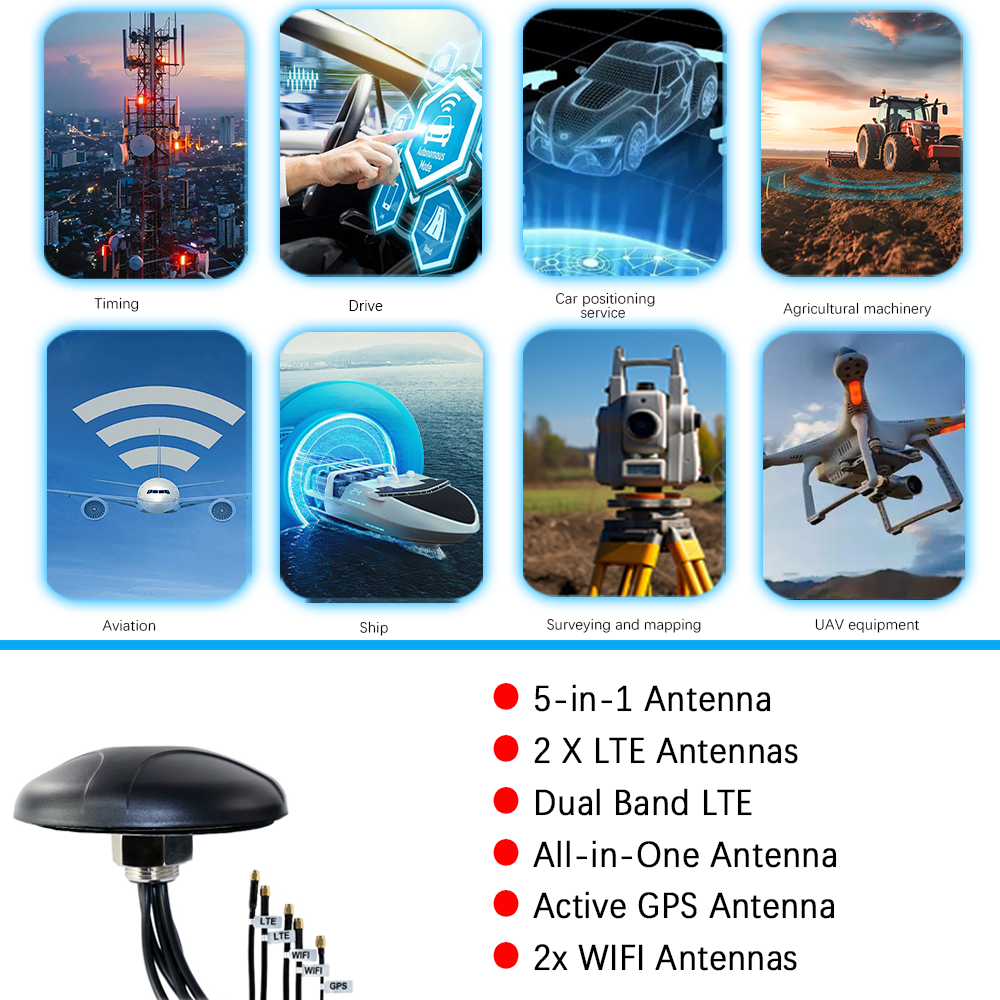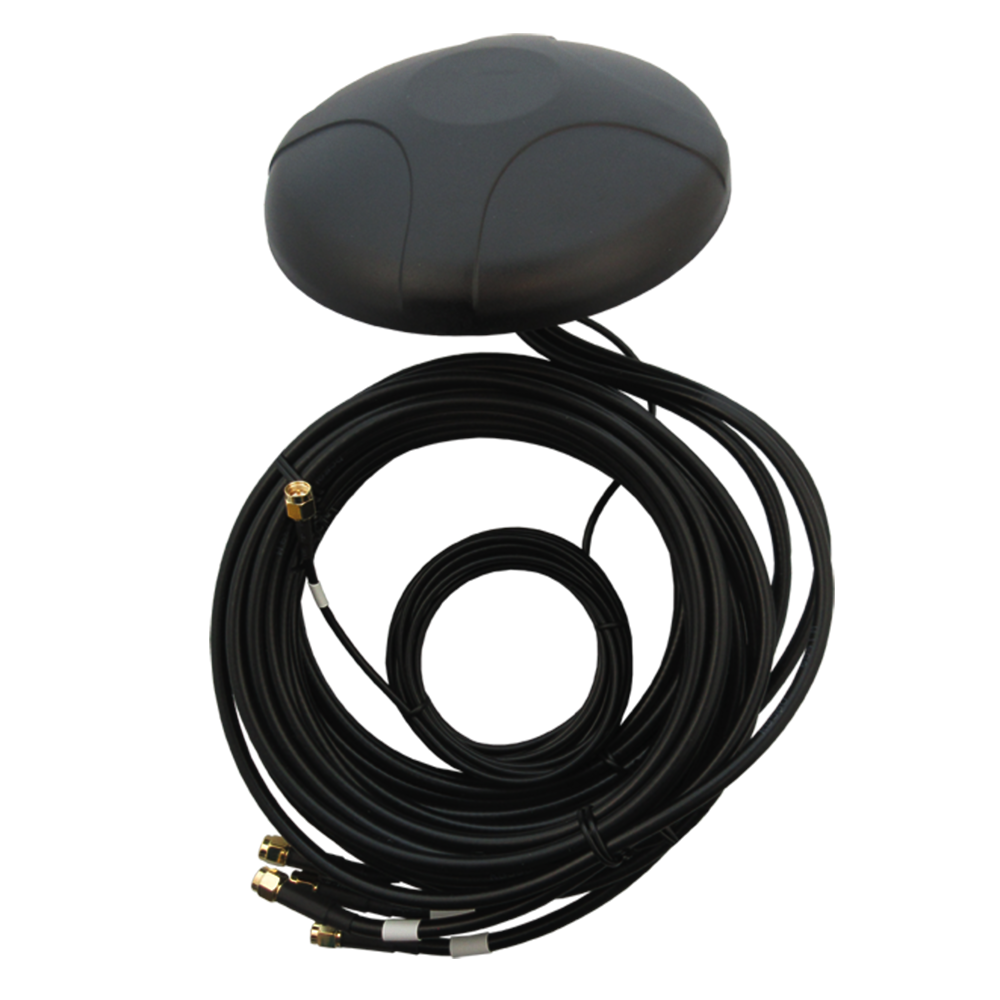The term "mushroom" in the context of this antenna refers to its distinctive physical design—a compact, rounded shape that resembles a mushroom cap, mounted on a base that connects to the device or vehicle. This design is not merely aesthetic; it is engineered to optimize performance while minimizing space, making it ideal for applications where size and aerodynamics matter, such as automotive use. The "GNSS combo" aspect highlights its ability to combine multiple satellite navigation systems (including GPS, GLONASS, and BDS) with cellular (4G LTE) and wireless (WIFI) communication, all in one integrated unit.
The design philosophy behind the Mushroom GNSS Combo Antenna revolves around three key principles: integration, efficiency, and reliability. By integrating multiple technologies into a single antenna, manufacturers eliminate the need for separate devices, reducing installation complexity, saving space, and lowering overall costs. Efficiency is achieved through advanced engineering techniques that minimize interference between different frequency bands, ensuring each technology operates at peak performance. Reliability is ensured through the use of durable materials and robust construction, allowing the antenna to withstand harsh environmental conditions, from extreme temperatures to heavy vibrations—common in automotive and industrial settings.
At the core of the Mushroom GNSS Combo Antenna is its ability to handle a wide range of frequency bands, as specified in the technical details provided. The GNSS component covers critical frequencies such as 1575 MHz (GPS L1), 1561 MHz (BDS B1), and GLONASS frequencies, ensuring accurate positioning across multiple satellite systems. The 4G LTE component operates across bands 824~960 MHz and 1710~2690 MHz, supporting cellular connectivity for data transmission and communication. The WIFI component, operating at 2400~2500 MHz, enables high-speed wireless networking, essential for applications requiring real-time data exchange. This broad frequency coverage makes the antenna a versatile solution for diverse connectivity needs.
To fully appreciate the capabilities of the Mushroom GNSS Combo Antenna, it is essential to examine its technical specifications in detail. Each component is carefully engineered to contribute to the antenna’s overall performance, ensuring seamless operation across multiple technologies.
Connectivity: TNC-K Connector
The antenna features a TNC-K connector, a type of coaxial connector known for its durability and secure connection. TNC (Threaded Neill-Concelman) connectors are widely used in RF (radio frequency) applications due to their ability to withstand vibrations and provide consistent signal transmission. The "K" designation indicates a male connector, which mates with a female TNC connector on the cable or device. This choice of connector is particularly important in automotive applications, where vibrations from the vehicle’s movement could otherwise disrupt the signal. The TNC-K connector ensures a reliable connection, minimizing signal loss and maintaining consistent performance even in dynamic environments.
Material: ABS (Acrylonitrile Butadiene Styrene)
The antenna’s housing is constructed from ABS, a thermoplastic polymer known for its strength, impact resistance, and versatility. ABS is a popular choice for industrial and automotive components due to its ability to withstand harsh conditions, including exposure to chemicals, UV radiation, and temperature fluctuations. In the context of the Mushroom GNSS Combo Antenna, ABS provides a protective casing that shields the internal electronics from physical damage, moisture, and dust, ensuring long-term reliability. Additionally, ABS is easy to mold, allowing for the precise, aerodynamic shape of the mushroom design, which reduces wind resistance and minimizes interference with the vehicle’s performance.
Polarization: Circular and Linear Options
Polarization is a critical factor in antenna performance, as it determines how the antenna receives and transmits electromagnetic waves. The Mushroom GNSS Combo Antenna offers circular polarization as a primary feature, with options for RHCP (Right-Hand Circular Polarization) and linear polarization. Circular polarization is particularly advantageous for GNSS applications because satellite signals are circularly polarized, allowing the antenna to receive signals regardless of the satellite’s orientation relative to the antenna. This ensures consistent reception even when the vehicle is moving or tilted, a common scenario in automotive use.
RHCP is the preferred polarization for many GNSS applications, as it matches the polarization of most satellite signals, maximizing signal strength and minimizing interference. Linear polarization, on the other hand, is often used for cellular and WIFI signals, which are typically linearly polarized. By offering both options, the antenna can optimize performance across different technologies, ensuring efficient signal reception for GNSS, 4G LTE, and WIFI.
Product Name: GLONASS BDS Antenna
The product name, GLONASS BDS Antenna, highlights its focus on two major satellite navigation systems: GLONASS (Global Navigation Satellite System), Russia’s counterpart to GPS, and BDS (BeiDou Navigation Satellite System), China’s satellite navigation system. This emphasis on multi-constellation support is a key advantage, as it allows the antenna to access more satellites, improving positioning accuracy and reliability, especially in challenging environments such as urban canyons or remote areas where satellite visibility may be limited. By combining support for GLONASS, BDS, and GPS (as indicated in the frequency range), the antenna ensures robust positioning capabilities across the globe.
Additional Connectors: SMA, FAKARA, MCX
In addition to the TNC-K connector, the antenna supports SMA, FAKARA, and MCX connectors, providing flexibility for different installation requirements. SMA (SubMiniature version A) connectors are widely used in RF applications for their compact size and reliable performance. FAKARA connectors, commonly used in automotive applications, are designed for quick and secure installation, making them ideal for vehicles where ease of maintenance is important. MCX (Micro Coaxial) connectors are even smaller than SMA, suitable for applications where space is extremely limited. This range of connector options ensures that the antenna can be integrated into various systems, from passenger cars to commercial vehicles and industrial equipment.
VSWR: 2.0
VSWR (Voltage Standing Wave Ratio) is a measure of how efficiently the antenna transmits and receives signals. A VSWR of 2.0 indicates that the antenna is well-matched to the transmission line, with minimal signal reflection. In practical terms, this means that most of the power from the transmitter is radiated by the antenna, rather than being reflected back, which could cause interference or damage to the equipment. A VSWR of 2.0 is considered acceptable for most applications, ensuring efficient signal transmission and reception across the antenna’s frequency bands. This is particularly important for the Mushroom GNSS Combo Antenna, which handles multiple frequency ranges—maintaining a low VSWR across all bands ensures consistent performance for GNSS, 4G LTE, and WIFI.
Gain: 28 dBi
Gain is a measure of the antenna’s ability to focus energy in a particular direction, expressed in decibels relative to an isotropic radiator (dBi). A gain of 28 dBi is extremely high, indicating that the antenna is highly directional and can amplify weak signals, improving reception in areas with poor signal strength. This high gain is particularly beneficial for GNSS applications, where satellite signals can be weak due to atmospheric conditions, obstructions, or distance. By amplifying these signals, the antenna ensures accurate positioning even in challenging environments. For 4G LTE and WIFI, high gain enhances data transmission rates, allowing for faster communication and more reliable connectivity.
The antenna is classified as a Glonass/GPS+24G+2WIFI MIMO Car Antenna, highlighting its multi-functional design. MIMO (Multiple Input Multiple Output) technology uses multiple antennas for transmitting and receiving signals, improving data throughput and reliability by leveraging multipath propagation. In this case, the antenna features 24G (two 4G LTE antennas) and 2WIFI (two WIFI antennas), enabling MIMO operation for both cellular and wireless communication. This results in faster data rates, better signal quality, and increased capacity—essential for applications such as in-vehicle infotainment, fleet management, and real-time monitoring.
The integration of Glonass, GPS, and BDS ensures comprehensive satellite navigation coverage, while the 24G and 2WIFI MIMO components provide robust cellular and wireless connectivity. This combination makes the antenna an all-in-one solution for modern vehicles, which increasingly rely on multiple connectivity technologies for navigation, communication, and entertainment.
Color: Black
The antenna is available in black, a practical choice for automotive applications. Black is aesthetically versatile, blending seamlessly with the design of most vehicles, whether mounted on the roof, dashboard, or rear window. Additionally, black absorbs heat, which can help regulate the antenna’s temperature in extreme weather conditions, preventing overheating and ensuring consistent performance. While color may seem like a minor detail, it plays a role in both functionality and user acceptance, making the antenna a practical and visually appealing choice for vehicle integration.
Frequency Range: Comprehensive Coverage
The frequency range of the Mushroom GNSS Combo Antenna is one of its most impressive features, covering multiple bands to support diverse technologies:
GNSS: 1575 MHz (GPS L1), 1561 MHz (BDS B1), and GLONASS frequencies. This ensures compatibility with major satellite navigation systems, providing accurate positioning worldwide.
4G LTE: 824~960 MHz and 1710~2690 MHz. These bands cover most cellular networks globally, supporting 4G LTE communication for data transmission, voice calls, and internet access.
WIFI: 2400~2500 MHz. This is the primary frequency band for WIFI (802.11b/g/n), enabling high-speed wireless connectivity for local area networking, device synchronization, and internet access.
This comprehensive frequency coverage allows the antenna to handle multiple tasks simultaneously, from providing real-time navigation data to supporting streaming services and cloud-based applications. It eliminates the need for separate antennas for each technology, simplifying installation and reducing costs.
Cable: 300mm RG174
The antenna is equipped with a 300mm RG174 cable, a type of coaxial cable known for its flexibility and compact size. RG174 is commonly used in RF applications where space is limited, such as in vehicles and portable devices. The 300mm length provides sufficient flexibility for installation, allowing the antenna to be positioned optimally while connecting to the vehicle’s communication system. The coaxial design of the RG174 cable ensures efficient signal transmission with minimal loss, preserving the integrity of the signals from the antenna to the receiver. This is crucial for maintaining the high performance of the GNSS, 4G LTE, and WIFI components, as signal loss can degrade positioning accuracy and communication speeds.
-
The versatility and performance of the Mushroom GNSS Combo Antenna make it suitable for a wide range of applications, from automotive to industrial and beyond. Its ability to integrate multiple technologies into a compact, durable unit addresses the connectivity needs of modern systems, ensuring reliable operation in diverse environments.
Automotive Industry
The automotive industry is one of the primary applications for the Mushroom GNSS Combo Antenna. Modern vehicles rely on a host of connectivity technologies for navigation, communication, entertainment, and safety. The antenna’s integration of GNSS, 4G LTE, and WIFI MIMO makes it ideal for supporting these functions:
Navigation: The antenna’s support for GPS, GLONASS, and BDS ensures accurate, real-time positioning, essential for in-dash navigation systems and advanced driver assistance systems (ADAS) such as lane-keeping assist and adaptive cruise control.
Telematics: 4G LTE connectivity enables telematics solutions, which provide vehicle tracking, remote diagnostics, and fleet management. This is particularly valuable for commercial fleets, allowing companies to monitor vehicle location, fuel consumption, and maintenance needs in real time.
In-Vehicle Infotainment (IVI): WIFI MIMO supports high-speed internet access, enabling streaming of music, video, and other content, as well as connectivity for smartphones and other devices via Apple CarPlay or Android Auto.
Connected Car Services: 4G LTE and WIFI connectivity support a range of connected car services, such as over-the-air (OTA) updates for vehicle software, emergency calling (eCall), and real-time traffic information.
The antenna’s compact, aerodynamic design and durable construction make it suitable for installation on various parts of the vehicle, including the roof, trunk, or dashboard, without compromising performance or aesthetics.




































































 Language
Language
 En
En Cn
Cn Korean
Korean

 Home >
Home > 







 18665803017 (Macro)
18665803017 (Macro)













